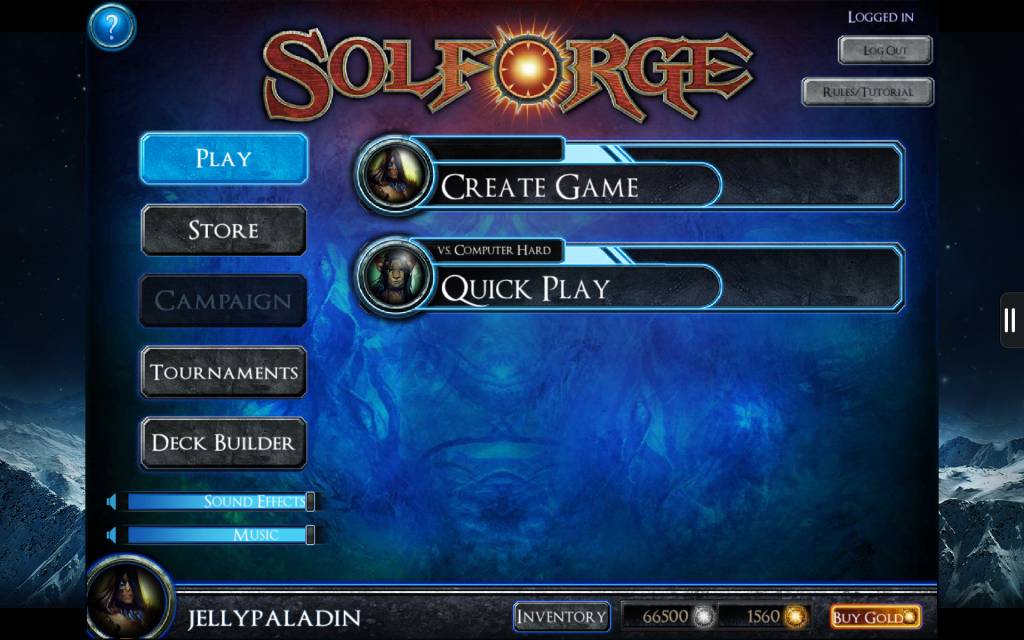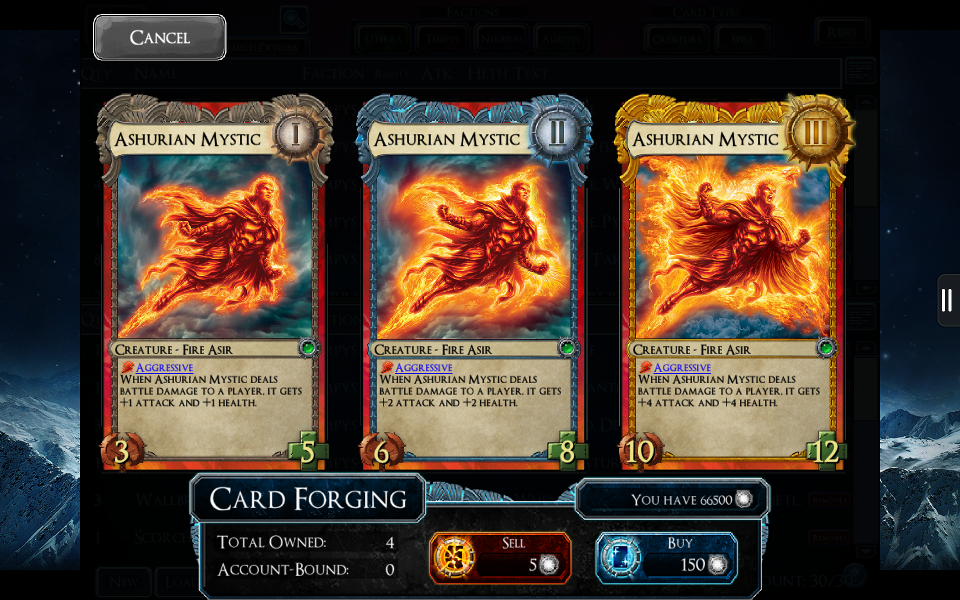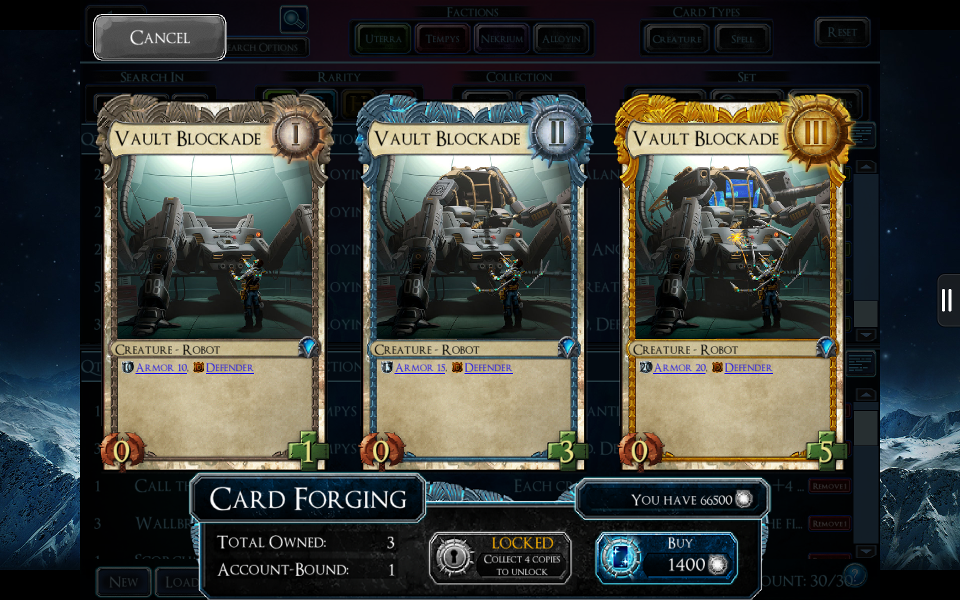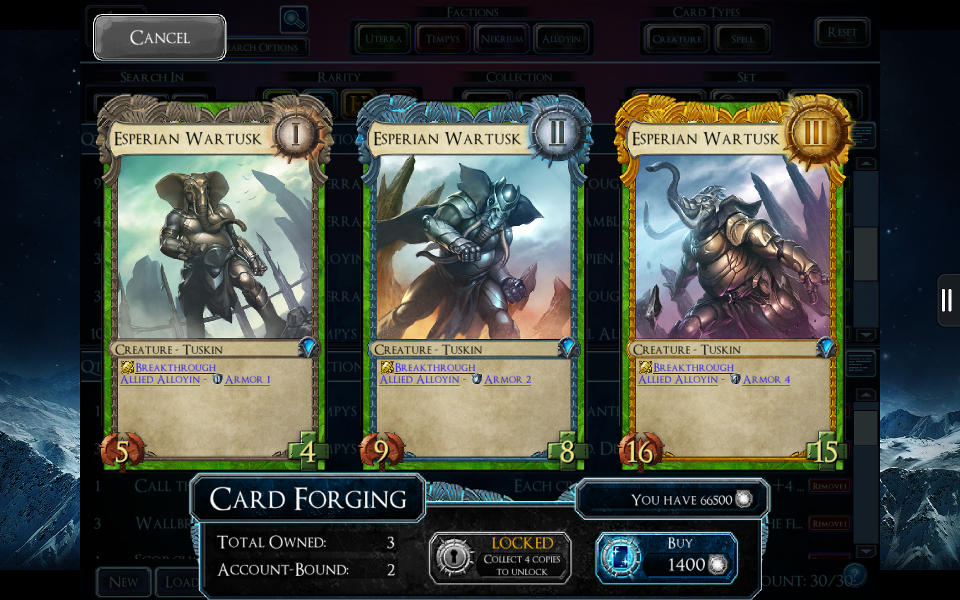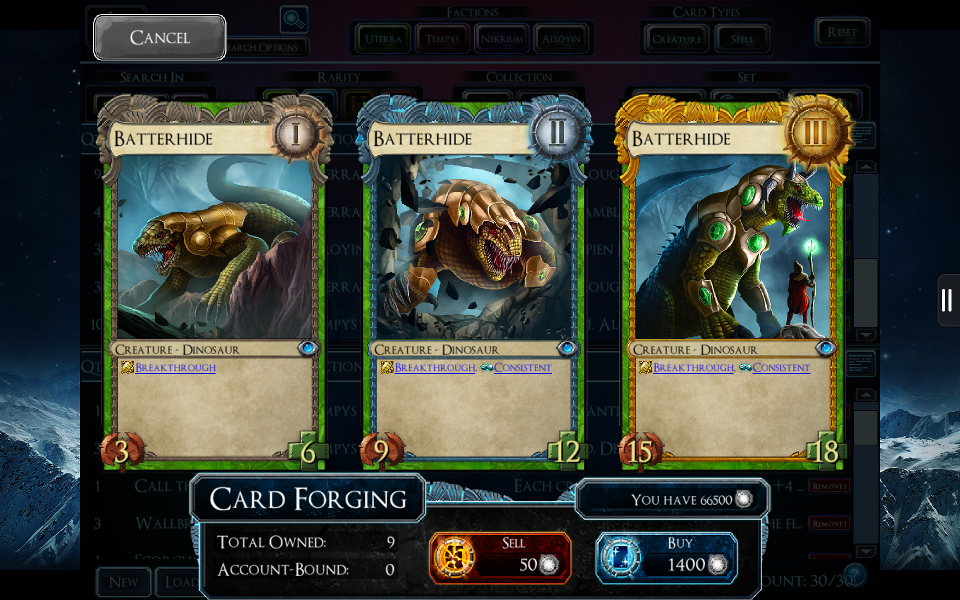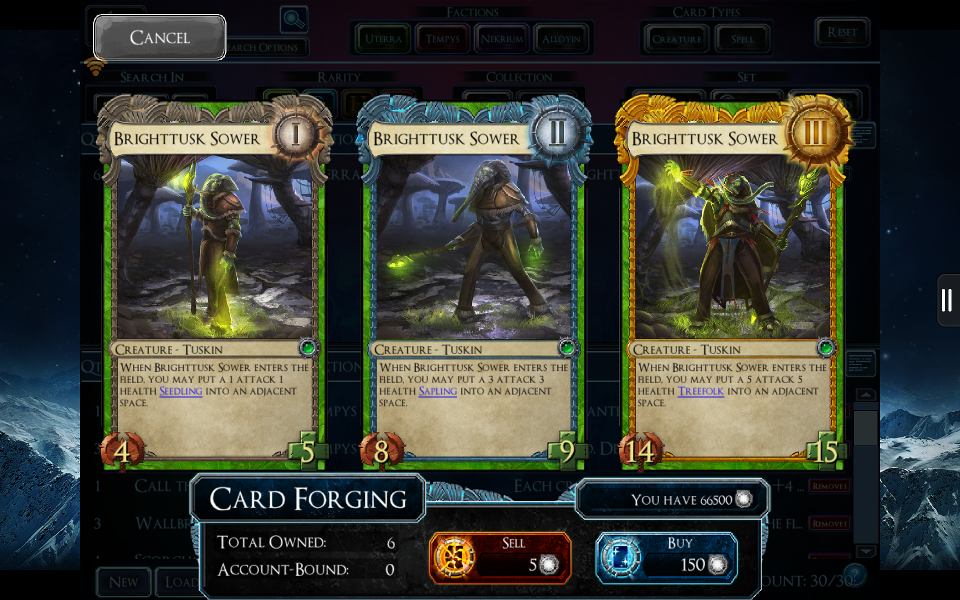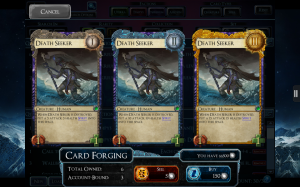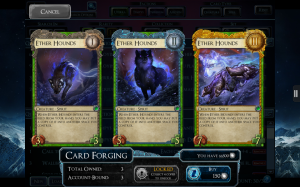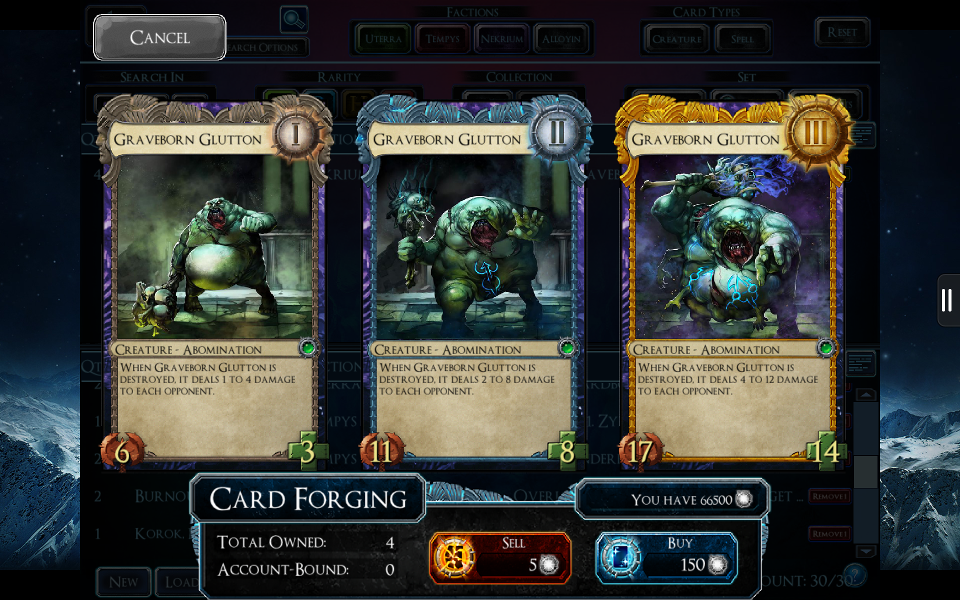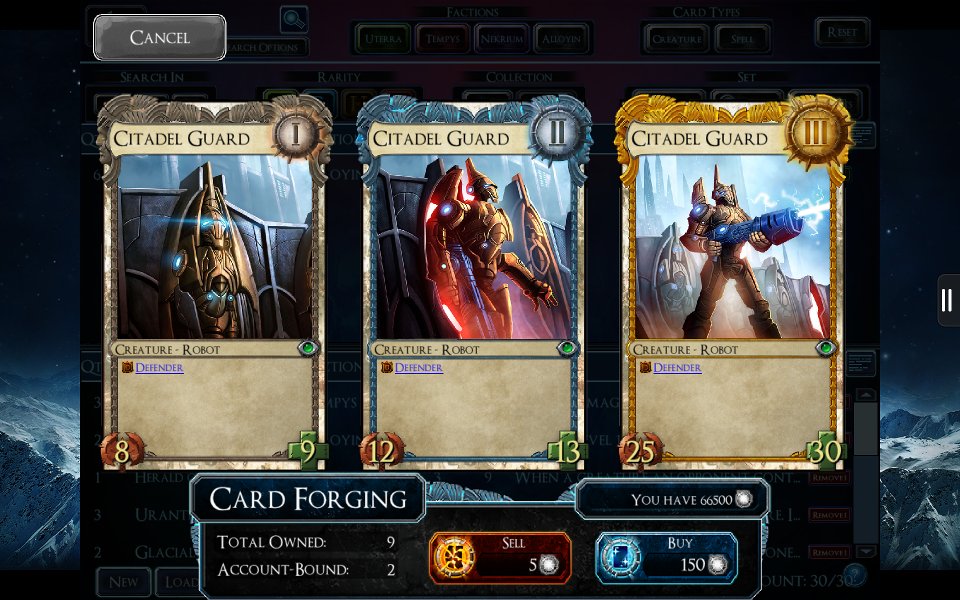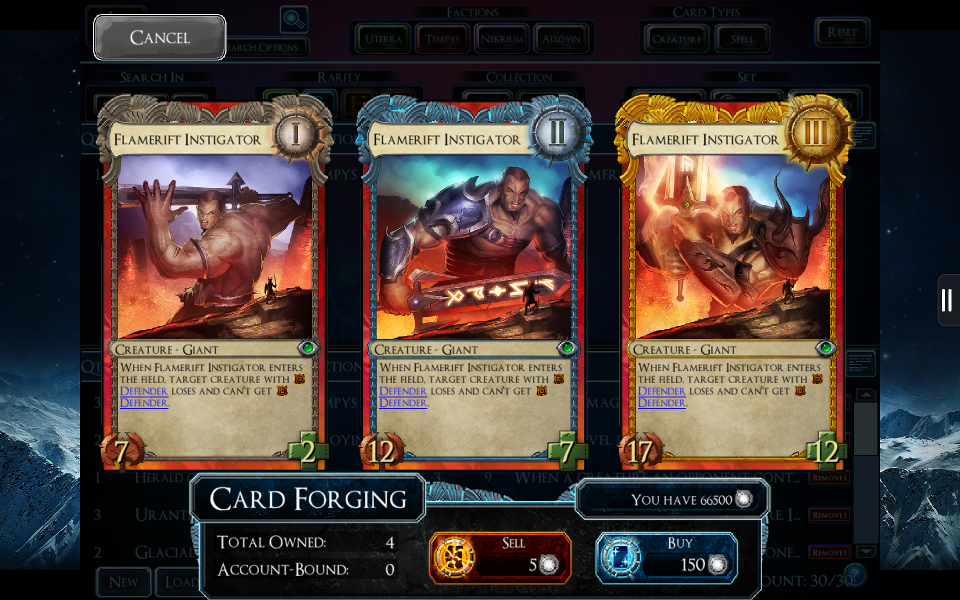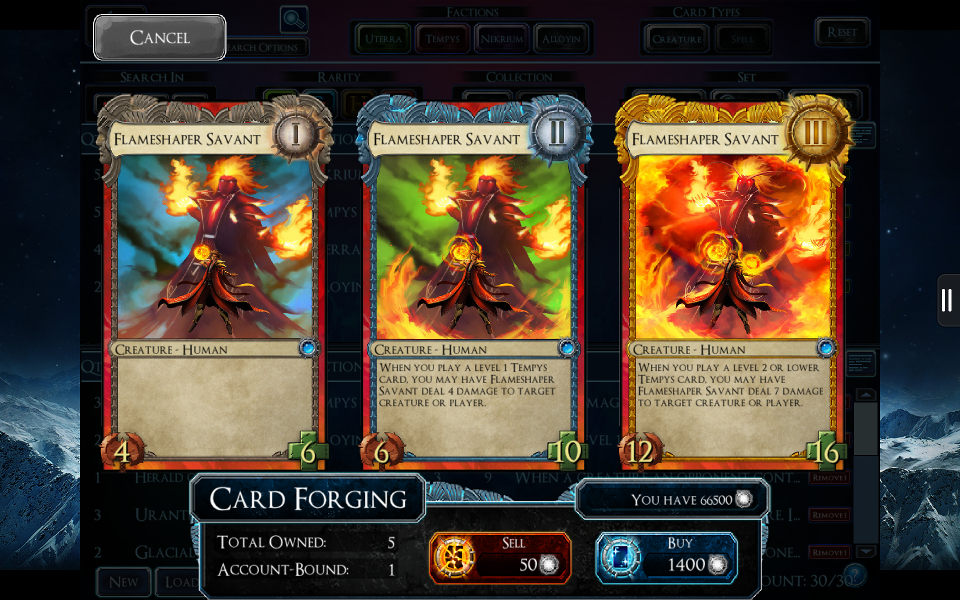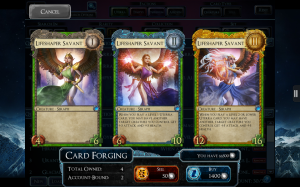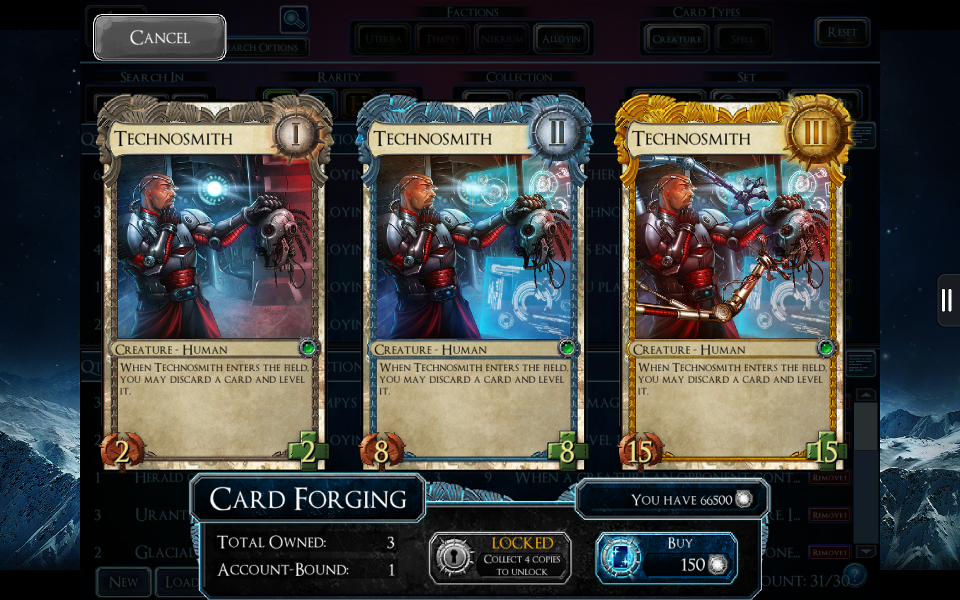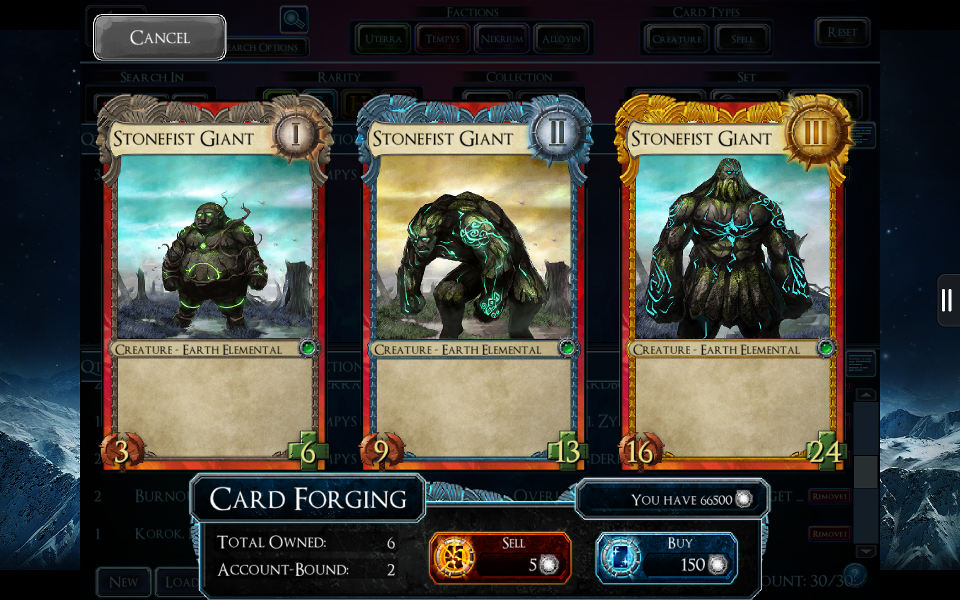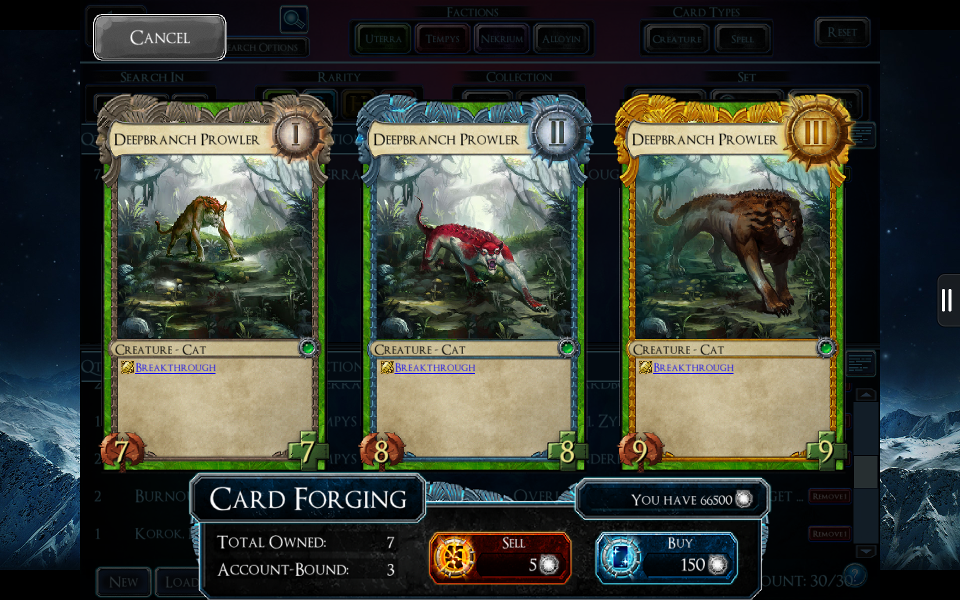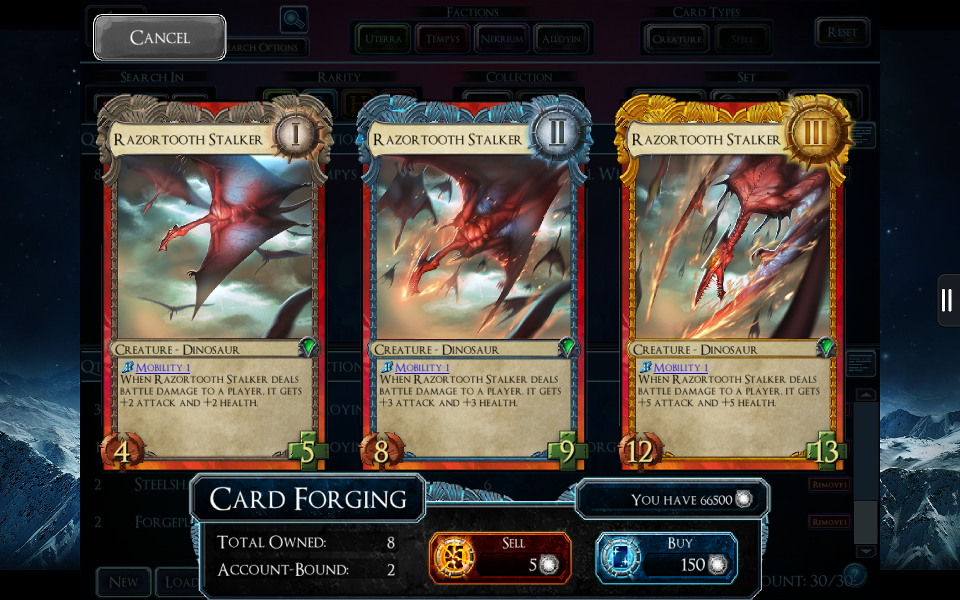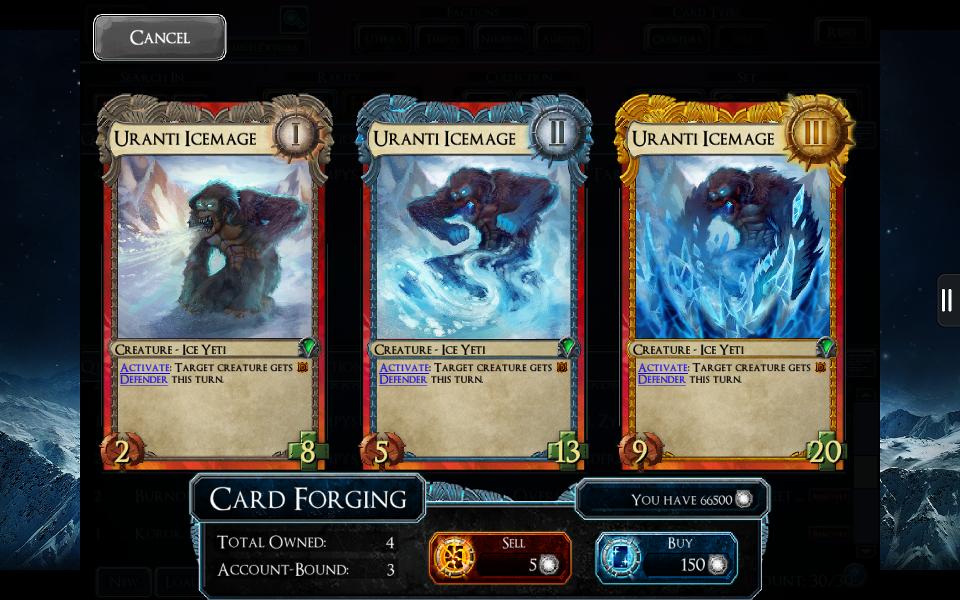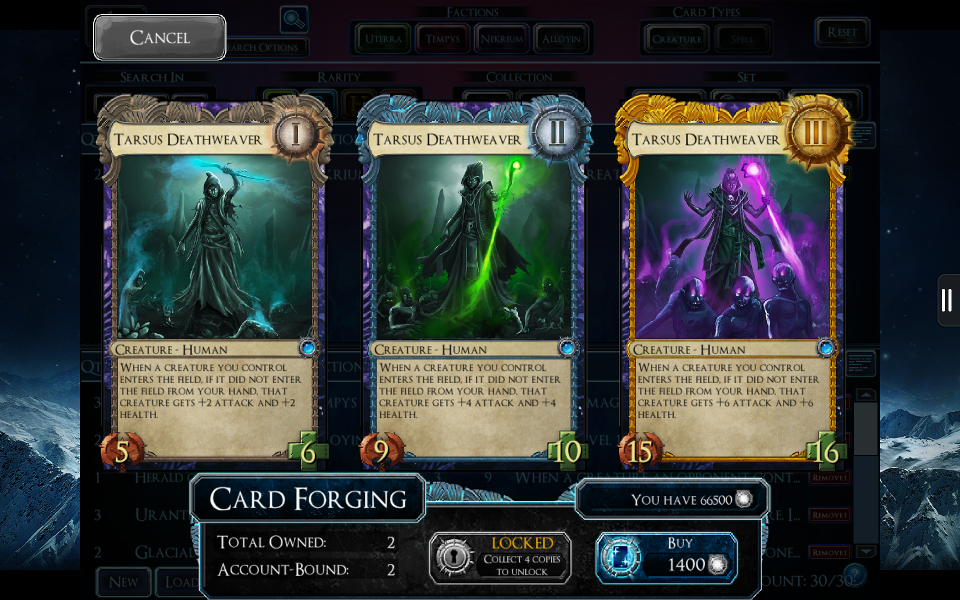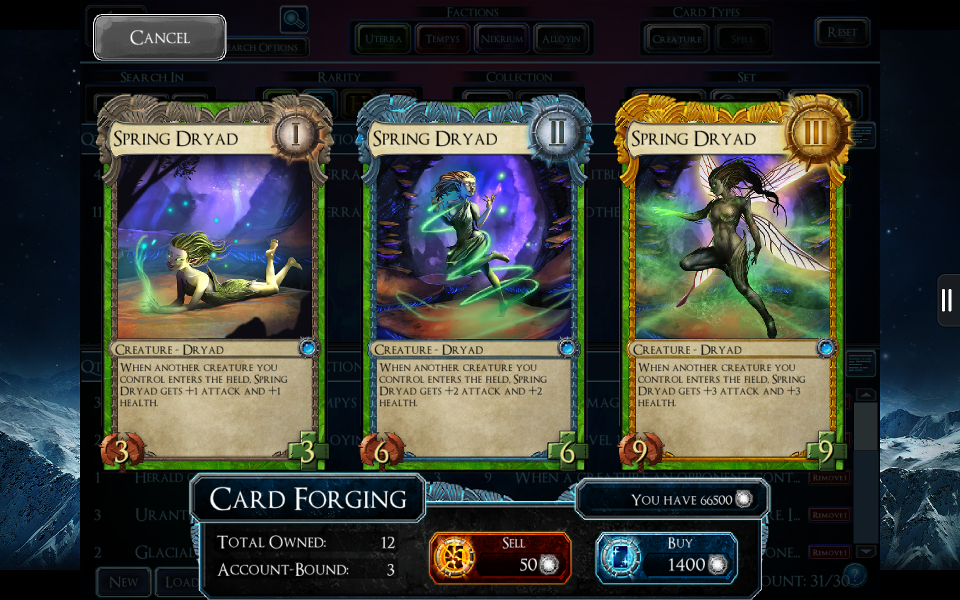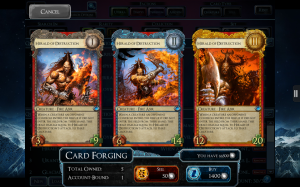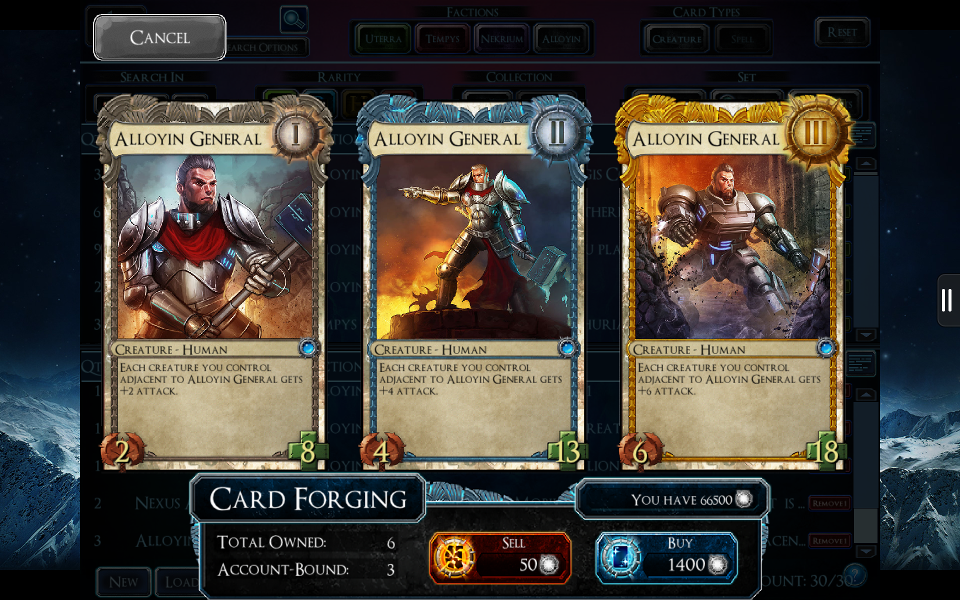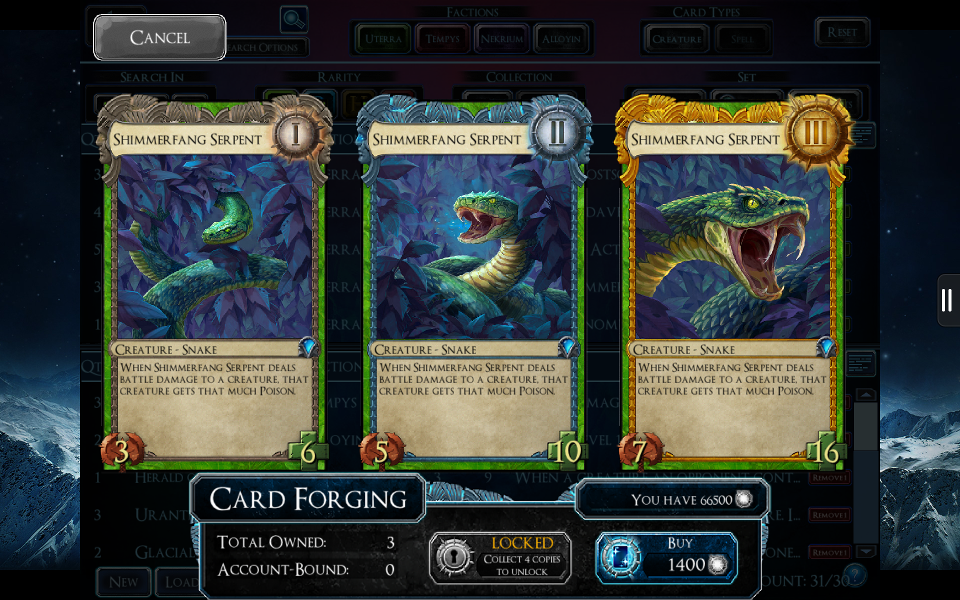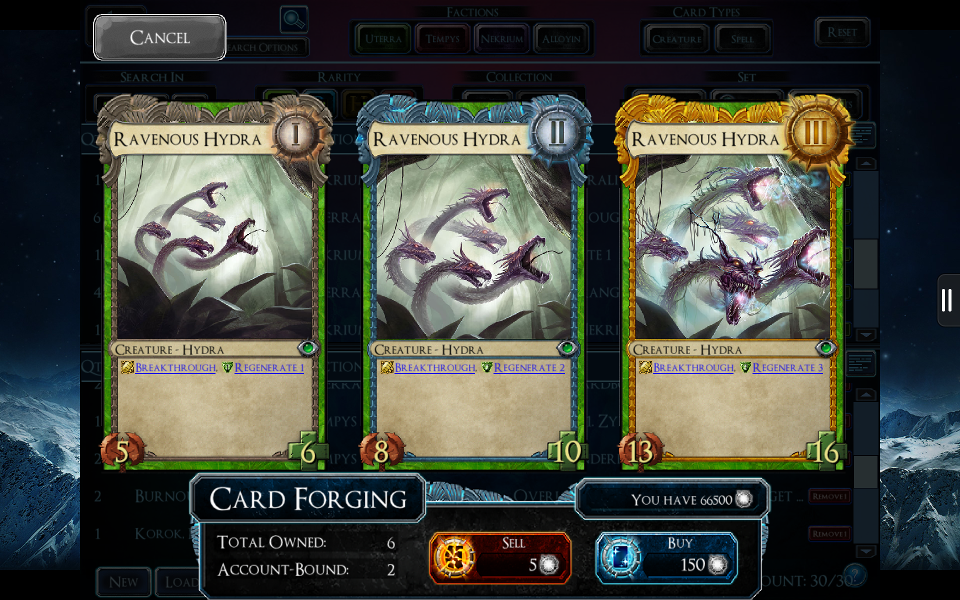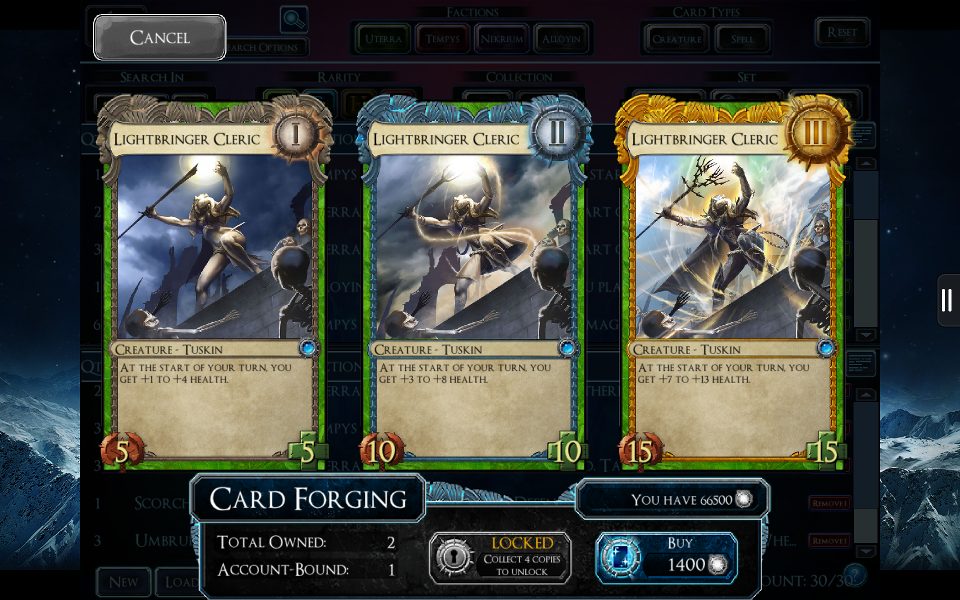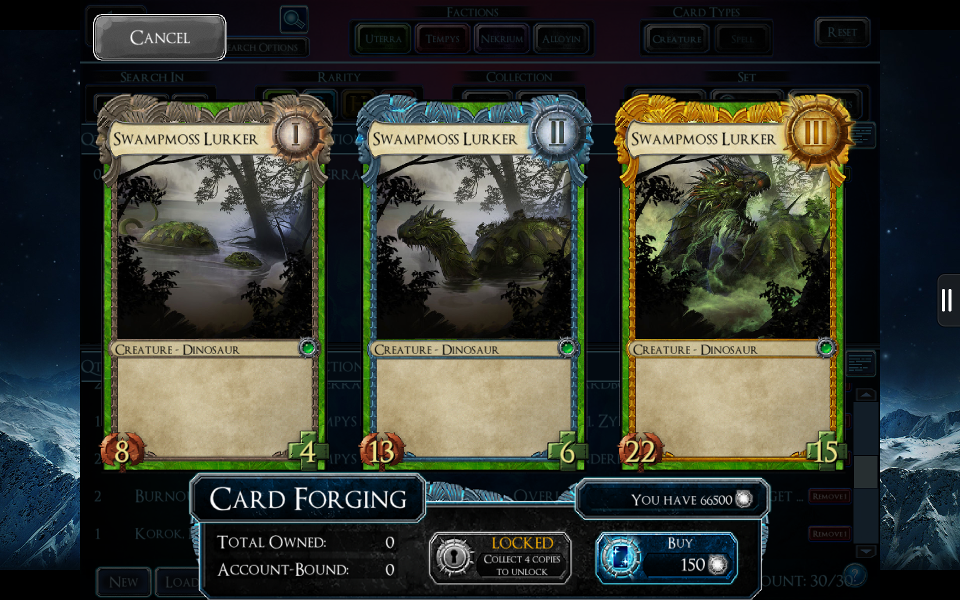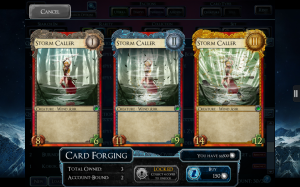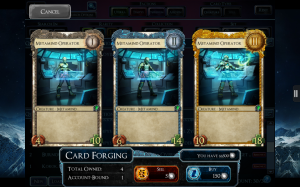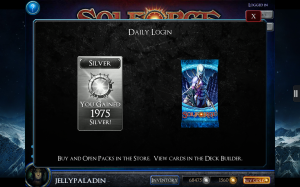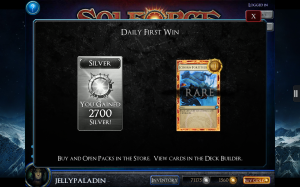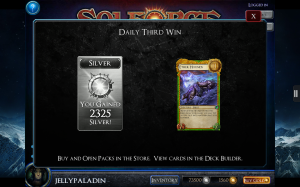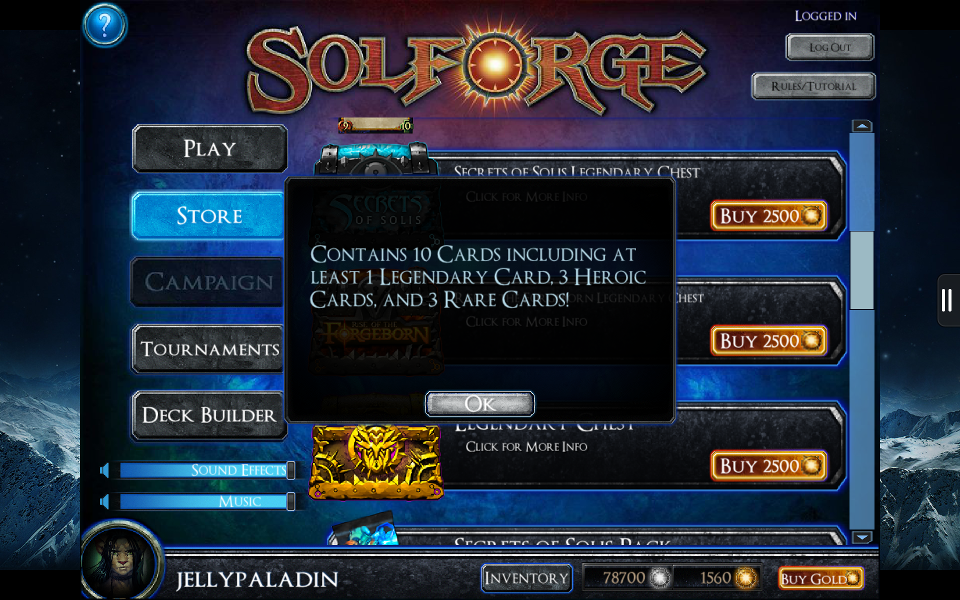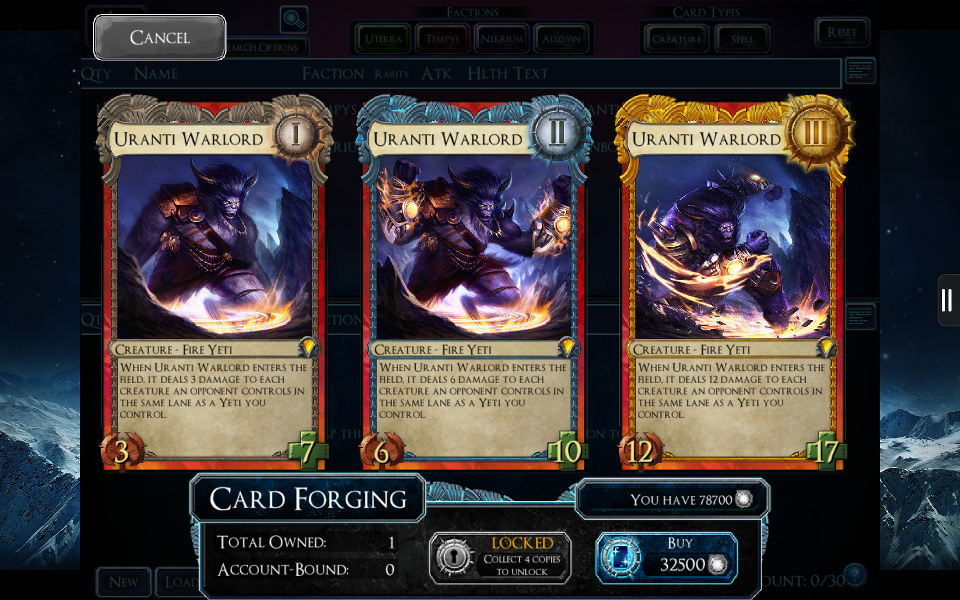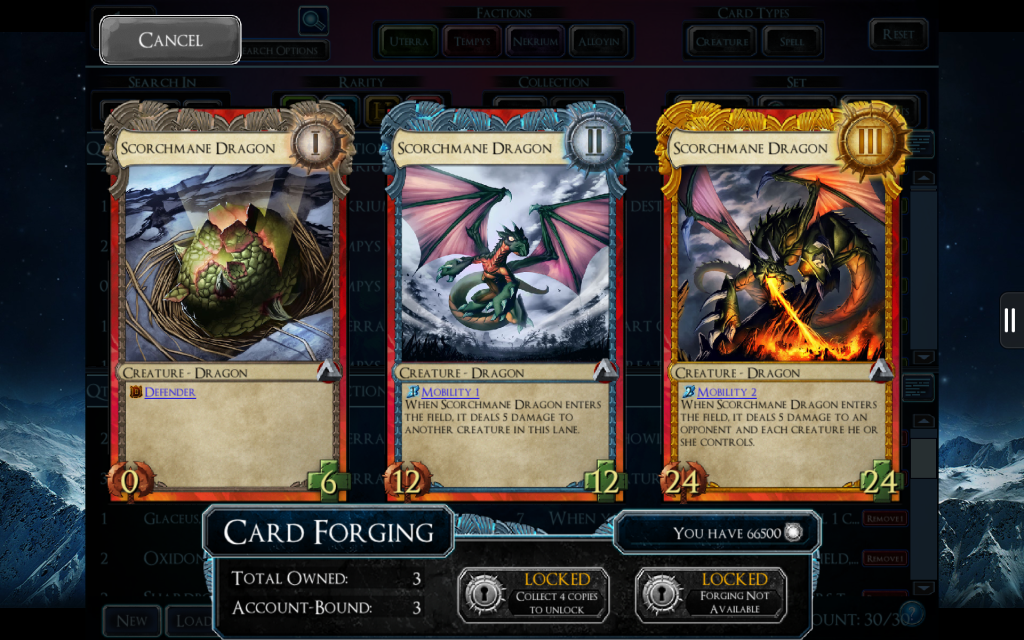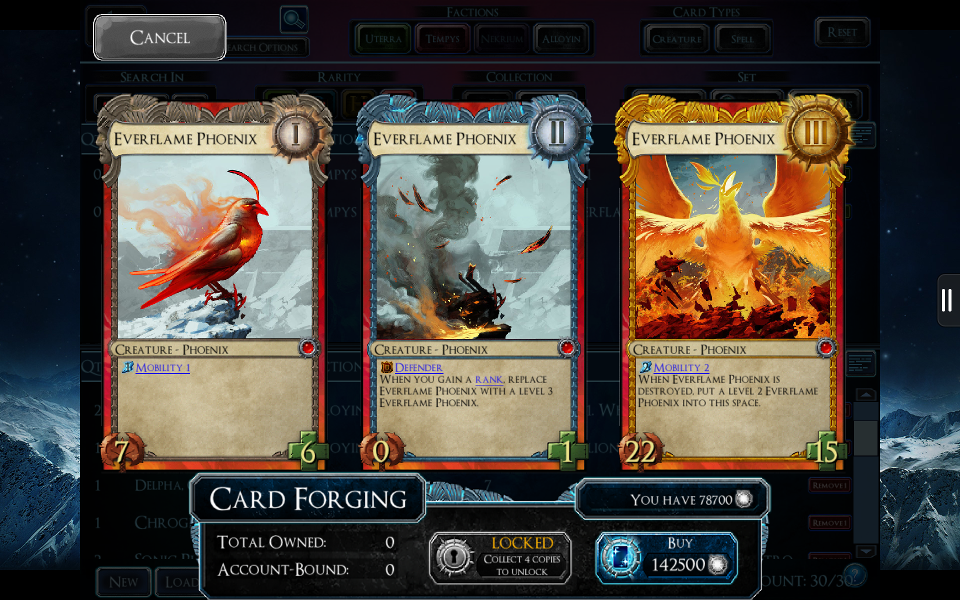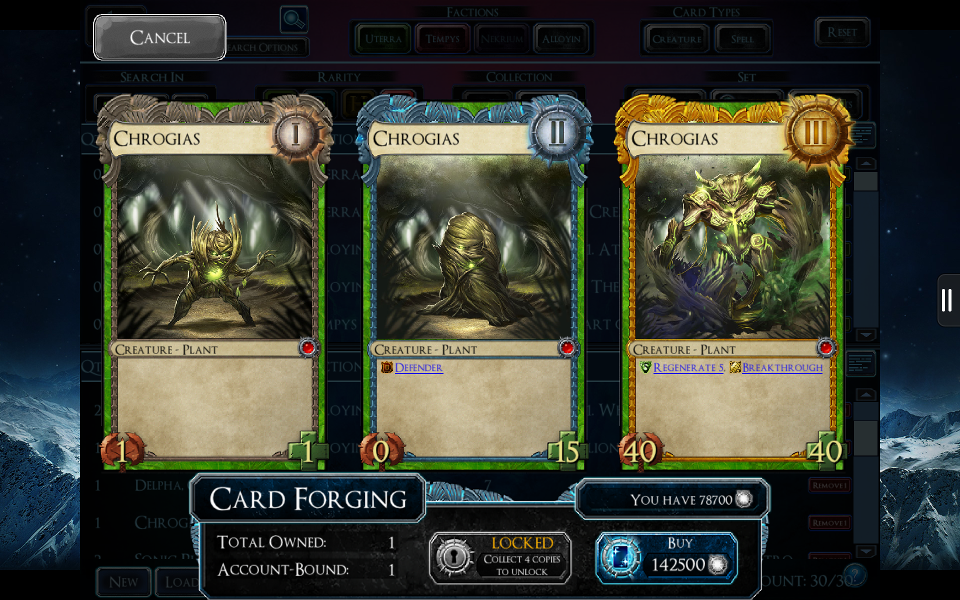Spoiler alert: the end of this review is very positive!
If you’re the tl;dr type (and this is very “tl” at 7,878 words), then I’ll say upfront that my final grade is an A-.
SolForge is free and you have nothing to lose by trying it—they don’t ask for credit cards or any other personal information upfront, unlike a certain other digital card game that I avoided specifically for that reason—so if you’ve somehow found your way to this page because you were looking for a SolForge review, then you should totally sign up and check it out. Preferably using this referral link right here! =P
With that said, for everyone who wants something meatier, here’s a full review of everything that I like and don’t about the game after three weeks.
Table of Contents
Section 1 – Details general basics of the game.
Section 2 – Details specific mechanics and why they’re interesting. Someone thinking about trying the game should read this; a veteran player can skip to Section 4.
Section 3 – Details the free-to-play model and how a new player can expect to ramp up card collecting.
Section 4 – Details potential areas of improvement and aspects of the game that still confuse me.
Closing Words – Wrapping it all up.
Section 1: Game Overview
Two years ago, thus declared the SolForge Kickstarter page:
The creators of Ascension and Magic: The Gathering have joined forces to create a revolutionary digital trading card game.
And furthermore:
Playing SolForge is absolutely free. You can earn cards and currency through gameplay to improve your decks without paying a dime!
Given these two statements, I don’t know which is more shocking: that they only raised $429,715 or that they somehow raised $429,715. After all, if the only thing money gets you is an accelerated digital card collection, why not just sink in more time? I’ve watched a large number of Kickstarter games bomb out specifically because they’re going to be free. On the other hand, this is the creator of Magic: The Gathering we’re talking about here—and so I put $60 toward it myself, the price I remembered for a Magic: The Gathering booster box last time I played in 2003.
Fast forward to mid-October 2014, around the 22nd or 23rd. (I know it wasn’t earlier than that and I’ll explain why later.) Despite my initial excitement for SolForge, I had never gotten around to playing it, mostly because too many promotional materials called it an open beta. In fact, I believe they’re still calling it an open beta even though people have been playing and paying since early 2013—but it’s a misleading description. The single-player campaign may not exist yet and the user interface could use some touch-ups, but the multiplayer core and deck building is all in place for a fine game.
So… What exactly is that game?
At its heart, SolForge is a fast-paced card game based around reducing your opponent’s health from 100 to 0 via creature combat. It has only two card types, creatures and spells, and you build a 30-card deck in which you can have a maximum of three of each card and a maximum of two of the four story factions (the equivalent of Magic’s mana colors). You draw five cards per turn, play two of them, and discard your hand at the end of turn to begin the cycle again. No cards nor creatures can be played on your opponent’s turn, but some creatures do have abilities that can be used once per your own turns.
All creatures have a power and health stat, of which power is generally more important for two main reasons. The first is that damage to creatures sticks permanently, so even creatures with high health can get worn down over time by chump blockers. The second is that creatures are played into five “lanes” and, once they’ve been on the field for a passive first two turns, they have to battle other creatures in their lane on both players’ turns (unless both are defenders, but more on that in a moment). All of this translates to a fast-paced game where creatures burn brightly and then flame out. Unblocked creatures, of course, deal damage directly to the opponent.
The main unique mechanic in SolForge, as described above by Stone Blade Entertainment, is that cards you play “level up” to stronger versions of themselves and go into your discard pile. Every four turns, you gain a rank (fans call it PL: player level) and your discard pile is shuffled into your deck so that you can have a shot at playing the leveled cards. Rank is the closest equivalent to resources in other card games in the sense that it controls the game’s tempo; you don’t start playing the big gun cards until at least turn 5 or even turn 9, so the first four turns are all about preparing for a strong mid-game and late-game.
Compared to Magic, the part of me who liked playing stupidly huge 7/7 green creatures that survive combat with everything misses that aspect a little bit—no creature has any sense of permanence until at least turn 9 and even then it’s iffy—but the part of me who liked playing massive swarms of 2/2 knights, elves, goblins, and other small creatures against each other gets that same vibe back in SolForge.
I can’t say too much more on a generalized level, so let’s get into the specifics of why this game is so cool.
Section 2: Gameplay Specifics
Since SolForge‘s card types are so few and the creatures are the heart of the game, they’re very robust and dynamic; it’s rare for a creature, especially a good one, to simply rely on massive stats. More likely they clone themselves, create a second creature, give you a free third card play for the turn, draw a card, do something when they hit the field, do something every turn while they’re on the field, do something when you play a spell, have passive permanent abilities, and so on.
As a recently-turned indie RPG developer/designer myself (as of February 2014), the interplay of creatures fascinates me endlessly. In fact, probably the biggest compliment I could pay to SolForge is that after a week of playing it, I thought to myself that if I didn’t know what to do with myself after completing my lifelong dream of a a turn-based RPG trilogy, then maybe I’d make a digital card game based on a hybrid of SolForge and Magic mechanics. And the second biggest compliment I could pay is that I jotted out a quick overview of what I’d do if I was in charge and found that I’d lean more toward SolForge mechanics!
Anyway, if you’re a veteran of the game reading this mostly to get impressions from a new player, then skip down to Section 4, but if you haven’t played the game at all, then I’ll run down all of the main mechanics that make creatures so interesting, showing off only commons and “rares” (more like uncommons, but they’re called rares) since a new player can expect to quickly build a huge collection of those:
Aggressive:
The aggressive ability allows a creature to start going after the opponent as soon as it hits the field. While this could be considered the SolForge equivalent of Magic’s haste, it’s actually better since creatures attack on both their player’s turn and the opponent’s turn. Note that the Human Torch here—a common card from the Tempys faction—not only has aggressive, but a second ability of getting permanently stronger whenever he connects with the player. His stats aren’t especially good to start off, but he also can’t be left alone or he’ll spiral out of control.
Armor:
Creatures with armor X are immune to X damage per turn. Vault Blockade, an Alloyin faction rare, is a prime example of a high-armor creature that can sit there and block a lane indefinitely; often even a level 2 creature can’t push through its level 1 form. At first I overlooked armor and didn’t grasp the difference between having armor or simply higher health, but the key distinction in SolForge is that chump blockers and small direct-damage effects can’t slowly eat away at it over several turns. Note that Vault Blockade is also a defender—it doesn’t actively attack (even if you boost its attack up from 0). More on that in the dedicated defender section.
Breakthrough (and Allied):
Breakthrough is essentially Magic’s trample, carrying over extra damage—if you have 10 power and attack a 2 health creature, 8 damage pushes through to the opponent. Breakthrough in this universe is much more important than trample in the Magic multiverse, though, for three reasons:
1) Your creatures always have to attack unless they’re defenders.
2) Enemy creatures lose health permanently, so something that shows up as a 6/6 might be a 6/1 when it’s time to break through it.
3) Chump blockers are all over the place, as seen two examples down.
This Esperian Wartusk from the Uterra faction also has armor with the Allied Alloyin mechanic. The Allied mechanic gives creatures (or spells) an extra effect as long as you have a card from the named faction in your hand.
Consistent:
Here’s an interesting mechanic that would be impossible in a physical card game. Since you draw five cards per turn, shuffle your discard pile back into your deck after four turns, and have a 30-card deck, this means that at any given rank (cycle of four turns) you only see the top 20 of your 30 cards (barring an extreme card draw deck).
The Consistent ability ensures that the leveled up version of a card will definitely be somewhere in that top 20 next rank. It may be #20 or it may be #4, but you’ll draw it at some point if you played it in the previous rank. Uterra’s Batterhide rare is the best Consistent creature you’re getting outside of the higher rarities, heroic and legendary, thanks to great stats (except at level 1) and breakthrough.
Copies, extra creatures, and replacement creatures:
One of the more unique mechanics in SolForge, some creatures are essentially two for one. Magic has this to an extent with token creators, but the five-lane system takes the strategy to a different level; it’s not about creating 39 Saprolings over time so that eventually the opponent can’t block them all, but placing creatures wisely to eat away at high-health creatures or push chip damage through empty lanes.
Note the careful balance of these three commons. Nekrium’s Death Seeker is a 1/1 and leaves behind a 5/5, a 10/10, or a 15/15 in its same lane. Uterra’s Ether Hounds is a 3/3, 5/5, or 7/7 that appears in any two lanes of your choosing. The total stat value is equal at level 1 or slightly worse at level 2 or 3, so generally Ether Hounds is better if you need to block creatures in two lanes, but Death Seeker is better if you need to block a single powerful creature for two turns consecutively.
Finally, Uterra’s Brighttusk Sower generates superior stat totals at level 2 or 3 (5/6, 11/12, and 19/20 compared to 6/6, 11/11 and 10/10, and 16/16 and 14/14), but can only place its extra creature next to itself. If your lanes are already cluttered or if the creatures you need to block are on opposite sides of the field, then it’s not the best bet.
These are only three examples; both Uterra and Nekrium have numerous others, like Grove Matriarch (the opposite of Death Seeker, she starts strong and then leaves behind a small creature in her lane) or Branchweaver Druid (a fusion of Death Seeker and Ether Hounds, he’s a 1/1 who creates a reasonably strong creature in any other lane of your choosing), and those deckbuilding decisions are rarely easy.
All in all, this is a major upside to SolForge.
Destruction-triggered abilities:
Some creatures, mostly in Nekrium like this common card, leave some kind of parting shot behind if they’re destroyed. Graveborn Glutton is a prime draft pick; on the one hand, opponents can’t leave it unblocked to deal huge damage, but on the other hand, blocking it deals damage too. Conundrums like this, in conjunction with the two-card-per-turn limitation and the knowledge that your card quality gets better at every rank, lead to interesting decision-making.
Defender:
Behind swarming copy/clone creatures, defenders are probably my second favorite thing about SolForge: they’re the best example of something this game does right that other games do wrong. In Magic, unless the game’s changed drastically in the ten years I’ve been away, there’s rarely a point to walls. They slow the game down, nobody has to attack into them, and their stats aren’t that much better than normal creatures anyway, so if they do attack into them, they’re probably winning or trading evenly.
Not so here. This Alloyin common, Citadel Guard, is a go-to example of a beastly defender. To put its stats in perspective, the general curve of a SolForge creature—the SolForge equivalent of Magic’s 2/2s as tempo creatures and 5/5s as fatties, if you will—is somewhere in the realm of 10 total stats at level 1 (4/6, 6/4, 5/5), 16-20 at level 2, and 30+ at level 3. I’ll talk more about this later as I get into behind-the-curve and ahead-of-the-curve cards.
Back to Citadel Guard, though, this thing is massive. 17 at level 1, 25 at level 2, and 55 at level 3—it’s always ahead of the curve, dramatically so at levels 1 and 3. And since creatures in SolForge have to attack whatever’s across from them, Citadel Guard gets to freely block whatever it feels like, then sit there in its lane while nothing ever parks in front of it because almost nothing’s surviving 8, 12, or 25 damage until you start getting into legendaries, the rarest of rare cards.
But here’s something that’s even cooler about defenders in this game. Suppose that a level 1 Citadel Guard has been weakened to an 8/4 because it blocked a 5/5. At this point, the opponent could toss a 4/4 in front of it. Without defender, Citadel Guard would attack on its turn and die (at least as much as robots can die). With defender, it won’t attack until the opponent’s next turn when the 4/4 becomes active. It’s sticking around longer, taking up your lane and taking up one of the opponent’s lanes with whatever’s meant to destroy it, buying you time.
Citadel Guard’s not an exception to the rule with defenders, either; most of them are also massive (not as much as Citadel Guard, but still more than attackers), have worthwhile abilities, or both. But what if you do want them to attack? Well…
Entry abilities:
One of the best commons in the game can turn your defenders into offensive powerhouses: Tempys’ Flamerift Instigator, whose ability activates as soon as it hits the field. It goes a long way toward mitigating the luck of the draw when even a level 1 Flamerift Instigator in level 3 can activate your Citadel Guard and do a huge 7 chip damage (or even finishing damage!) as a chump blocker in the process. When Instigator is leveled himself, he has enough raw power to take out almost anything he feels like—sacrificing himself in the process because of low health, of course, but it’s worth it to trigger an enormous defender who can take out two or even three creatures before going down.
That’s a card for a very specific type of deck, though. A more general-purpose card is Uterra’s Shardbound Invoker common, who either shows up and turns itself into a beast or chump blocks and turns something else into a beast. And that effect isn’t the equivalent of Giant Growth from Magic—the +3/+3 is permanent.
Faction-triggered abilities:
Sort of the opposite of the Allied mechanic, some creatures give you bonuses whenever you play underleveled cards of the same faction. Tempys’ Flameshaper Savant rare is probably the best of these because he can either remove creatures or push damage through directly to the opponent, both extremely valuable, plus his faction is arguably the best at playing low-level spells.
I also included Lifeshaper Savant because you can see how well she works with the previous example’s Shardbound Invoker. Play them on the same turn and you get two creatures plus two +3/+3 bonuses to toss around as you see fit, which can either push extra damage through with an unblocked creature or allow a blocked creature to survive one more turn and take down more creatures.
Leveling, ahead of the curve cards, and behind the curve cards:
Although this Alloyin common technically has an entry-triggered ability, Technosmith gets his own section because the leveling mechanic is exclusive to his faction. Unlike in Magic, a 2/2 at level 1 is horrifically bad, but the upside is that he levels an additional card—so playing him puts two level 2 cards into your deck (himself and another card), which can start being drawn from turn 5 on. The obvious question then, is when it would be worth setting yourself back.
This is where the power curve of SolForge comes into play. Most of the best extreme examples are sadly legendaries like Chrogias or Scorchmane Dragon or Iron Maiden that a new player isn’t likely to have for a while, but to go with a common that’s kind of comparable, I’ll take Tempys’ Stonefist Giant:
He’s a 3/6 at level 1, which is acceptable but not amazing, but then levels into a 9/13 and a 16/24. Remember, the rough power curve is 10 total stats at level 1, then 16-20, then 30+. This means that as long as you can get him past level 1, Stonefist Giant is a beast both at attacking and blocking, as well he should be since he’s a vanilla creature with no abilities. He’s what I call a “behind the curve” creature who starts off slow but then ramps up. So to get around playing him, you can play Technosmith and level him.
But then the question arises: even if level 1 Stonefist Giant isn’t amazing, he’s far better than Technosmith, so why not play him directly? The answer does depend on how the game field looks, but usually my answer would be this: because Technosmith himself is also a behind the curve creature.
If you don’t want to play a level 1 Technosmith at rank 1 when people are tossing around 4/6s and 5/5s, then you really don’t want to play him at rank 2 when people are tossing around 10/10s and 12/7s. Better to have an 8/8 level 2 Technosmith and a 9/13 level 2 Stonefist Giant waiting to be drawn than a 2/2 level 1 Technosmith and a 9/13 level 2 Stonefist Giant. With 100 health on your side, you can handle taking some hits in the early game to establish a stronger late game.
The previous Flameshaper and Lifeshaper Savant examples could also go with Technosmith to an extent. Their level 1 forms are on-the-curve 4/6s, but their true (and incredible) value shows up at level 2 and 3, so you could play Technosmith and bypass playing their initial forms. (The downside there is, of course, that the Savants’ abilities are watered down when they’re not in single-faction decks, so ideally a card like Technosmith would be one of your only Alloyin cards.)
Overall, this leveling mechanic single-handedly saved the Alloyin faction for me. I had no interest in it before playing SolForge because I like fantasy over sci-fi, but this extra card leveling is the closest thing this game has to mana ramp.
Before I leave this topic, though, here’s one example of a creature you definitely don’t want to use Technosmith for:
Here’s an Uterra common that starts off incredible (14 at level 1), then becomes average (16 at level 2), then finally terrible (18 at level 3). Deepbranch Prowler is great in draft tournaments, but only if you play it carefully: its value is that its level 1 form of a card is enough of a powerhouse to take out tons of level 2 creatures, especially against low-health factions like Tempys and Nekrium, so you don’t need to level it.
Mobility:
Found primarily in the Tempys faction, mobility lets a creature move around by X lanes in either direction on your turn, which makes blocking it quite a bit tougher unless you’re loading up on creatures that spawn extra creatures. This helps it push damage through, avoid enemy blockers that would destroy it, or move to take out your opponent’s key creatures as you see fit. Razortooth Stalker, like the Human Torch in my first example, can not only move around, but gets stronger whenever it connects. And all that from a common!
Once-per-turn abilities:
Creatures like this Tempys rare and common can use activated abilities once per turn after becoming active (being on the field until their player’s next turn). These abilities run the gamut and can generally do just about anything on this list—grant armor, raise a creature’s stats, grant mobility, deal damage, and so on.
In these examples, the Flamestoke Shaman can make one of his fellow creatures aggressive. The opponent generally wants to take him out as quickly as possible, but on the other hand, his 6 power is no joke; whatever blocks him will often go down with him. Uranti Icemage is in the opposite boat, stopping enemy creatures from attacking (and it also has synergy with other Tempys cards that destroy defenders). It can also turn one of your own creatures (including itself) into a defender to keep them alive for one more turn if they would otherwise be forced to attack into an opposing creature with the power to destroy them.
Other-creature-entry abilities:
Rather than triggering when they enter the field, some creatures trigger when other creatures enter the field. Nekrium’s Tarsus Deathweaver rare is probably the strongest of the bunch (again outside of higher rarities), turning those tiny 1/1 and 3/3 extras you’re spawning into threats in their own right, while Uterra’s Spring Dryad rare is also highly notable for becoming her own single enormous threat. Either one could be the cornerstone of a deck.
I show Herald of Destruction here mostly as an example of triggering by opponents‘ creatures. He’s not that great without boosting his attack (though he can block for a good while with that health), but it’s just an example.
Passive abilities:
The Alloyin General rare boosts the attack power of his adjacent buddies as long as he’s alive, which will be longer than most creatures due to his health. He’s a good example of the interesting interplay of SolForge‘s mechanics of lanes and always-active attackers; despite being not that strong in his own right, he’s often a high-priority target for opponents’ removal because of his passive boost.
Poison:
Poison is a status effect that certain Uterra creatures and spells can inflict and does X damage at the start of each turn. Our rare card Shimmerfang Serpent here isn’t much to look at for raw attacking force, but as a blocker this is pretty great, especially in draft tournaments.
Consider this: normally if you have a 5/5 blocking a 4/6 (like Flameshaper Savant) then both of them will die at the same time since they go down to 5/1 and 4/1, then finish each other off. Shimmerfang Serpent, though, blocks the 4/6 and deals 3 damage, then 3 poison damage kicks in at the start of the next turn, leaving the Serpent alive as a 3/2 (and ready to poison another target who dares to get in front of it).
Of course, what this creature really loves is a Shardbound Invoker buddy or something else to pump its attack and poison enemies more severely.
Rank-triggered abilities:
Creatures like this Alloyin common, Metamind Overseer, give you a benefit at the end of your every fourth turn. You usually have to play these on either your third or fourth turn to ensure their survival, but the creatures tend to be fairly solid in their own right, so even if the timing’s off, they’ll do in a pinch for an otherwise-poor hand. This is probably the best of the common and rare rank-triggered abilities since you really want to pull at least one of your highest-leveled cards as soon as you enter a new rank.
The opposite scenario is also possible—the heroic card Ebonskull Knight has amazing stats but self-destructs at the end of every fourth turn. In that case you hope to play it on turn 1, 5, or 9 instead of 4 or 8.
Regenerate:
The opposite of poison, regenerate heals X health per turn and is found mostly in Uterra and Nekrium. In a game where health loss is otherwise permanent, this can be highly useful—with even so much as regenerate 1, this Ravenous Hydra could be put down to block a 3-power creature and heal off two of the damage before anything else has a chance to touch it. Nekrium regenerators typically have better healing but less power than Uterra regenerators, so the choice is between occupying space to prevent damage to the player or having a creature that can be buffed into a credible threat.
Spell-triggered abilities:
Here’s an example of a Nekrium rare that can occupy the same lane twice in a row like Death Seeker and has better stats, but comes with the restriction that it only does so if you play a spell (which also means it’ll only do so on your turn). Since Nekrium probably has the best overall spells other than Tempys, that’s not too tough to work around.
Turn-triggered abilities:
Lightbringer Cleric, a Uterra rare, is the very definition of a creature that’s exactly on the curve at every level and comes with an extra ability that activates for free every turn. There actually aren’t too many creatures with turn-triggered abilities like this, usually opting for either passive abilities or those once-per-turn abilities that activate if and only if (and when) you want them to. I haven’t figured out the exact mechanics yet of whether poison damage or life gain kicks in first when a turn begins, probably because poison is fairly rare. However, set 4, which releases today, looks like it’s trying to turn that around quickly.
Vanilla creatures:
Finally, a word about vanilla creatures: even they often have their own unique flavor in SolForge. Uterra’s Swampmoss Lurker has absurd power at level 1 and 2 but low health, making it good for taking out higher-leveled creatures when sheer damage is all you need, but then at level 3 it has both health and power going for it. It’s the kind of card you’re usually happy to draw or play at any moment.
Tempys’ Storm Caller is similar but often more useful thanks to cards in her faction like Flamestoke Shaman. In a game where players have 100 health, pushing 8 damage through anywhere in the first four turns is big and makes hyper-aggro decks plausible. Her level 3 form doesn’t compare to Swampmoss Lurker, but her first two are even better. I’ve lost games in drafts due largely to players repeatedly flinging Storm Callers all over the field with mobility tricks so I can never catch them.
And now consider Metamind Operator. I overlooked this Alloyin card for a long time because, like I said, power is usually much more important than health in this game. The exception is when health is this extreme. Nothing in the game including legendaries has 10 power at level 1, which means that Metamind Operator survives literally every unboosted level 1 creature, so it’s doing at least 8 damage over the course of two turns. Its level 2 form is likewise doing 12 damage; I don’t know of anything with 14 power at level 2. All of this pairs up very well with buying you time for Alloyin’s leveling engine.
Other mechanics:
Though it’s not found below the heroic rarity level, the solbind mechanic means that a single card also puts additional cards in your deck. Sometimes these cards are unique to the solbinder; Funguy doesn’t exist as a useable card outside of Tuskin Sporelord. Other times the cards aren’t; Forge Guardian Delta adds copies of other normal cards.
Aside from the fact that cards with solbind always have strong synergy with the solbound cards, this mechanic has two interesting effects: letting you bypass the 30-card limit and letting you bypass the 3-of-a-single-card limit. Three Tuskin Sporelords means you’ll have six total Funguys in a deck of 36 and three Forge Guardian Deltas means that you could have up to six each of Forge Guardian Alpha, Beta, and Gamma in a 39-card deck.
This is a double-edged sword, though, when you remember that you only draw 20 cards per rank—add too many of these and you’ll be drawing more level 1 cards during rank 2 than expected. The question is whether you can handle the tradeoff.
Aside from that, set 4 will also introduce some mechanics like upgrade (replace one of your existing creatures with the new creature to give the new creature some benefit) and assault (play a creature into an empty lane with nothing across from it to gain some benefit). Plus there’s a Uterra legendary who can pull something back out of your discard pile and into your hand, which is new to the game. I’d also like to note that the nature of a digital card game makes it possible for Stone Blade to patch cards and either buff or nerf them, both of which have been done. Until set 4, they could only do this infrequently with major game updates, but now they’ll be able to react more quickly if broken or unplayable cards pop up.
This section has already gone on for thousands of words, so I won’t get into spells other than to say this: the best thing about them is that they tend to be valuable even without any leveling. A level 1 creature in rank 1 is almost always more welcome than a level 1 spell, but a level 1 spell in rank 3 is exactly always a more welcome sight than a level 1 creature—and often a more welcome sight than a level 2 creature and sometimes even a more welcome sight than a level 3 creature. Spells are generally used to just push through that final bit of damage either by directly hitting a player for damage, giving breakthrough or mobility to an enormous creature, or destroying an opponent’s blocker.
Deciding what to play and when to play it is a key element of the game.
Section 3: Card Collection Model
Amidst all the complex deckbuilding decisions and creature synergy, the most baffling element of SolForge is outside of the gameplay: if the game is free, then why sink money into it anyway? And it’s not just technically free; it’s pretty generously free. Let’s run down how much so.
As screencapped above, you get big rewards three times per day (resetting at midnight Pacific time (GMT -8)) for logging in, winning one game (which can include going against the computer on easy and giving it the worst deck in the world), and winning three games. As not screencapped above because the notification flashes by so quickly that it’s tough to catch it, you also get one event ticket for your first online win of the day, used as part of an entry fee into tournaments—but more on that later.
The first three rewards always include a wad of silver (the game’s free currency) and one other random bonus like a single card, a basic booster pack, or occasionally an event ticket or legendary chest. This example was an above-average payout of 7000; I’ve been logging how much I collect and my average is 6572, with the highest being 7350 and the lowest 5425.
But what does all this translate to in card value? In SolForge, you can obtain cards for your collection either on a per-card basis or in packs of random cards. The à la carte method is priced as follows:
- Commons: 150 silver (given my average rewards, you can create 43.81 of these per day)
- Rares: 1400 silver (4.69 per day)
- Heroics: 32500 silver (0.20 per day)
- Legendaries: 142500 silver (0.046 per day)
Alternatively, you can buy boosters for 5000 silver, which are packs of six cards where at least one of them is rare or better. People who have been playing for ages and tracking their packs (with a dedication reminiscent of Pokémon shiny hunters trying to figure out exact shiny rates) have determined that there’s roughly a 5% chance of a heroic and a 1% legendary rate in SolForge boosters. Translate that to a 1625 value and 1425 value respectively, with the rare itself being a 1400 value, and you can see that unless you need a very specific card, boosters are a good proposition relative to buying cards one by one.
…but what’s coming out with Set 4 is a far better proposition. Until now, legendary chests could only be bought with gold (the game’s paid currency) or won through daily rewards, but now they’ll be available for 100,000 silver. What does a legendary chest contain?
Ten cards wherein at least one is legendary, at least three are heroics or better, and at least three are rares or better. I can’t even make up how good this is. Legendary chests are the big value: one individual legendary costs 142.5% as much as the entire chest while three heroics and three rares also cost 101.7% as much as the chest. The only downside here is that you can’t target specific cards.
Still, look at how valuable that is—and then consider that it’s also possible to win a legendary chest from the daily rewards. I’ve won at least two that way and I’ve only been playing since October 22, 2014. And that’s not counting the free legendary chests you get for 10 wins (including wins against the computer), 100 wins (likewise), and 10 online wins.
And amidst all of this is the other daily reward: for one online win per day you get an event ticket to enter a casual draft tournament (costs three tickets), competitive draft tournament (seven tickets), or a constructed tournament (four tickets). Full details can be found here, but for my purposes of trying to figure out what’s going on with SolForge‘s card collection model, let’s simplify it.
First off, I’ll presume an average player and that means constructed tournaments don’t exist; nobody’s competing in those except people who have huge pockets of either money or time. This leaves the two draft tournaments, where our average player goes exactly 2-2 every time. The rewards and playing rate would be as follows:
- Casual draft: play 2.33 times per week (7 times every 3 weeks), winning 46,600 silver, 4.66 boosters, and 2.33 bronze prize packs—essentially boosters with slightly higher rates of heroics and legendaries.
- Competitive draft: play once per week, winning 70,000 silver, a silver prize pack (better rates than a bronze prize pack), and the 30 cards you draft—the first card of which is always a heroic.
The first thing I can say is that these draft rewards seem a little backwards. For a hardcore player who already has a full collection of cards and just wants to play the game, casual draft is better because you can play it much more often; conversely, for a relatively new player like me who needs everything I can get, the drafted cards in competitive draft have huge collection-building value (especially if extra heroics or a legendary show up for grabs) and that’s the place I’ll want to be.
The second thing I can say is that 46,600 silver is almost half of a legendary chest and 70,000 is, of course, exactly 70% of a legendary chest. Add in your average daily silver allotment of 46,004 and, for a totally free-to-play account, you get 0.99 legendary chests every eight days if you like playing casual draft or 1.16 legendary chests every week if you like competitive draft.
All of this adds up to SolForge being a game where time isn’t money—it’s actually more valuable than money. Rather than putting cash in to support the game, it’s ironically very, very easy to simply build a collection gradually with free and very quick rewards. Either play early and play often (i.e. sign up now for the low, low price of $0.00 =P) or jump in late and spend money to catch up to other people who have been around a while.
Section 4: Areas of Improvement
4A) Tribal decks.
Right now SolForge only has a few creature types who are meant to team up in huge numbers in a single deck and build synergy with each other: yetis (Tempys), zombies (Nekrium), abominations (Nekrium), robots (Alloyin), metaminds (Alloyin), and plants (Uterra).
That would be fine, but there are many more creature types who don’t synergize with each other—just off the top of my head, there are dinosaurs, humans, spirits, a seraph, a phoenix, insects, spirit wanderers, dryads, elementals, dragons, asirs (basically shaman characters), snakes, bears, cats, dogs, tuskins (elephant people), giants, grimgaunts (basically those soulless warriors from Lord of the Rings), hydras, vampires, and likely others that I’m missing, and all of this is true with only three released sets.
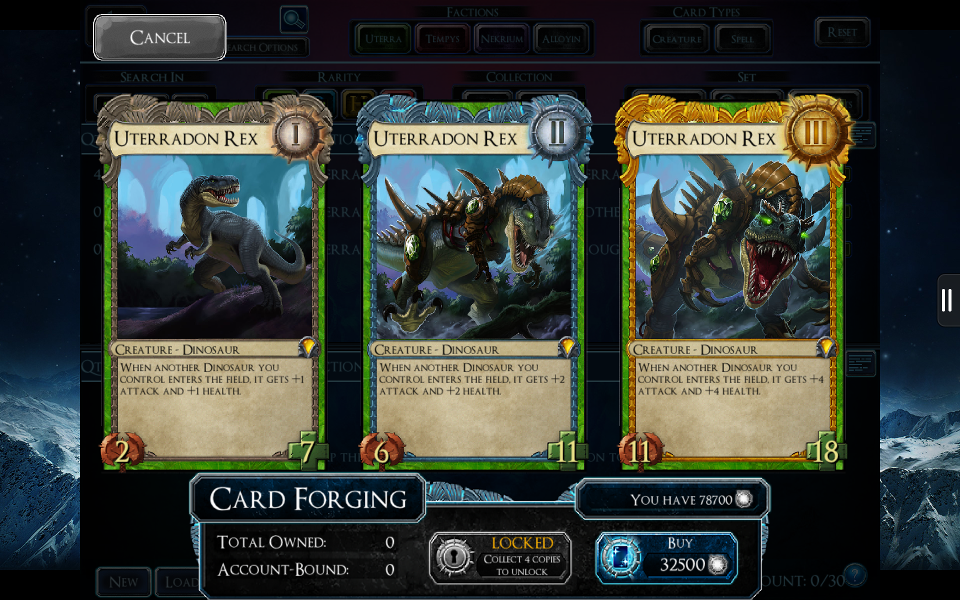
One of these heroic cards forms the backbone of a powerful tribal deck archetype. The other, despite having what might be the most common creature type in the game and a pose very reminiscent of Dinosaur Comics, is kind of junk. [Update: Rex's attack is being buffed by 2 at each level in the set 4 patch, so maybe it'll be viable now!]
SolForge is well-thought-out in terms of card mechanics and balance, making for complex deck-building decisions—this creature with armor goes with that creature who also has armor, this creature with regenerate goes with that creature who has regenerate, and so on, which is great, but other times I’d rather just lump together creatures of the same type for fun. In a way, this criticism is also a compliment: I’m saying the SolForge world is too filled with interesting creatures for only a few of them to be viable archetypes.
Don’t underestimate the simplistic charm of simply amassing a theme deck—in Magic you can make a deck of angels, dragons, elves, goblins, zombies, clerics, merfolk, soldiers, knights, beasts, faeries, illusions, and just about any other creature type in the game. These won’t always be competitive, of course, but the fun is that it’s possible at all.
Maybe this will correct itself over time as more and more cards are released, though. It’s not like Magic had everything from the word go; maybe one day I’ll be able to make a SolForge deck of giants, a deck of dinosaurs, a deck of dryads, and a deck of seraphim.
4B) A Sealed format.
As much as I love draft, my favorite type of Magic tournament was sealed and SolForge could benefit from that format. Since this is a game without lands, the equivalent of a tournament pack is simply extra booster packs, so it’s perfectly plausible. Either allow three-faction and four-faction decks in the format (already possible in special rulesets during limited-time weekend tournaments), give out a massive card pool that players don’t keep afterward, or use the code from draft tournaments that generates booster packs with cards only from the first two factions you pick.
However it’s done, more formats are better!
4C) Matchmaking and/or a permanent Unlegendary format.
With all of the positive energy I’ve put into saying how well-thought-out SolForge is, it’s surprising but true that I almost quit the game in my second week of playing.
I was getting thrashed over and over in my first week, but of course I chalked that up to learning something new. Everything seemed fresh and exciting and I felt like I was playing a game that had hit upon something brilliant. I started to seek out information—the SolForge forums, streamers talking about their thought processes going into drafts, competitive communities, and so on.
I learned about underdrops, win conditions, compensating for variance with even card leveling, multi-lane plays, the rule of 6, knowing your counters, dedicating a small portion of your deck to your counters’ counters—all of this is beyond the scope of this review, but suddenly the game made a new level of sense.
And then I found that sometimes knowledge doesn’t matter. As I entered the queues for games against random people, I would either run into people who I destroyed or people who destroyed me—rarely if ever a close game—and that usually the difference maker was our card quality. My $60 from Kickstarter had gotten me somewhere, not the least of which is a full playset of these three beauties…
…but it hadn’t gotten me as far as the people who had been playing for 15+ months (either that or spending more money) and amassed huge collections of legendaries. Sure, the common Citadel Guard at the same level as the legendary Scorchmane Dragon defeats it one-on-one and survives, but you can’t have a deck of 20 Citadel Guards and 10 Flamerift Instigators. Most cards aren’t on the dragon’s level, so my dragons outclassed people I faced without legendaries, but I in turn was outclassed by people I faced with 10+ legendaries. Most of the time I’d run into near-identical decks too—the moment I saw any one out of “Ghox, Metamind Paragon,” “Killion, Infinity Warden,” “Ironmind Acolyte,” or “Suruzal, Emissary of Varna,” I pretty much knew what the rest of the deck would be.
Over time I’m guessing that I could have learned how to beat or at least compete with those decks even while limiting myself to the tools of commons, rares, and heroics. When I look back, I do see holes in my thought processes. Still, losing in blowouts didn’t form the core of my questioning whether I should keep playing. Neither did winning in blowouts. It was those two factors plus the lack of diversity in decks. There seemed to be no sophisticated matchmaking to put me against people on my own level. I want people with my records—inconsistent records that indicate they’re probably experimenting just like me. Good matchmaking, assuming the player base is big enough for it (I don’t know whether it is), would go a long way toward improving the SolForge experience.
So at the end of all this, my decision—my near-quitting point—was that I should just play for the free daily rewards and draft when I could, slowly building a collection until I was ready to return to true competition with other people some weeks or months later.
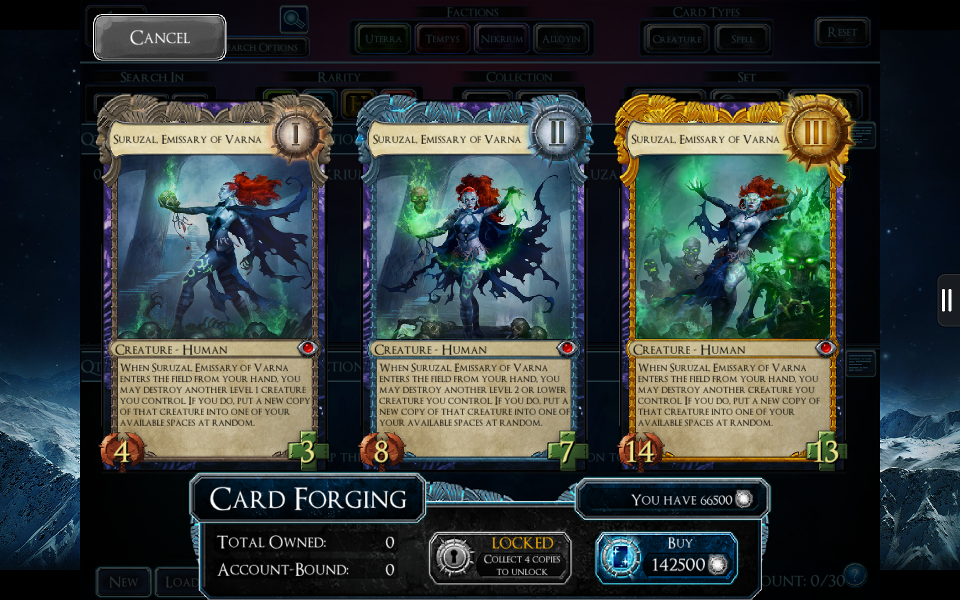
Hi, Suruzal. I know what you’re here for. Can’t do anything about it, though.
And then, just a few days ago, I discovered an unofficial fan community ladder that holds frequent tournaments in Unlegendary formats (no legendaries allowed) or even Unheroic formats (no legendaries and no heroics). They’re free to enter and they give out prizes—better prizes, in fact, than the tournaments in the SolForge client itself. Because decks of that caliber are perfectly within my reach, this has breathed so much life back into the game that I’m more excited about it now than I was in those first few days.
…but not everyone knows about Kaelari’s unofficial ladder, so it’s not a substitute for having such an option in the game so that every player will see it. I know, of course, that it must be tough for Stone Blade Entertainment to balance the casual and competitive markets. If a deck of all-commons and rares could compete in the top tier, then no one would have incentive to put money in to keep the game alive.
I believe there’s a balance, though, where a game can have casual players who keep playing with the intent of working their way up. To that end, I wouldn’t recommend Unheroic as an official SolForge format since the daily rewards would let anyone compete there endlessly for free—but I would recommend Unlegendary. Like I mentioned in Section 3, a person can make a heroic card once every five days, they’re a nice dangled carrot while legendaries feel out of reach.
4D) Store prices.
Another thing that didn’t help during my almost-quitting mode is when I learned that the $60 Kickstarter store credit that I’d sunk into a bunch of legendary chests (and a couple preconstructed decks) would have gotten me twice as far if I had just started playing the game two or three days sooner. There was a Kickstarter-backer-exclusive tournament on October 25th and I started just a couple days earlier—but not as early as October 20th, when Stone Blade had held a half-off sale on legendary chests.
Missing that sale wouldn’t have bothered me if not for two facts:
1) A look back in the news archives revealed that they held half-off sales on different things every few months: legendary chests in October, precons in September, legendary chests earlier in September, legendary chests in July, legendary chests in May, every item in part of January and part of February, and so on. So why should anyone ever buy anything at full asking price?
2) …but out of these sales, only the January and February one was mentioned in Kickstarter updates even though they do use Kickstarter updates to let us know about other things, including two mentions of the exclusive tournament.
All of that is a really bitter pill to swallow even now. :/
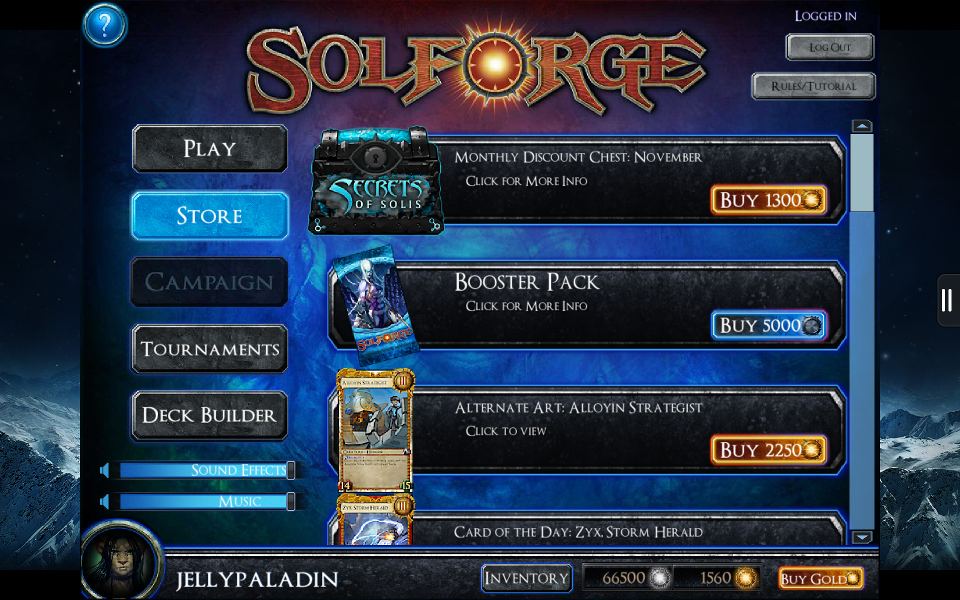
Even the monthly discount chest, which you can only buy once, technically costs more than the half-off sales that happen all the time.
Yes, I fully own up to my ignorance on how I used my store credit—it’s not their fault, I made assumptions (Magic never went on sale in the years I played), and sales are their prerogative. And a person might even ask why I should spend money anyway on a free game. Fair enough. But at least I’ll say that I’m never spending money again without a half-off sale.
It’s kind of like how I’ll back a Kickstarter video game for $10 and then two weeks later it shows up on IndieGameStand as a $1 preorder deal with a time window of four days. I try to be at least kind of philanthropic because, hey, I’m a game developer too and I want to support all these people, but at some point you have to ask yourself if you’re being more generous or more stupid.
And that’s the crux of it: in an otherwise glowing review of a very high-quality game that’s thoughtful and exciting and well-designed, why does SolForge make it so easy for me to recommend that you go try it but so difficult to recommend that you spend money to keep it alive? (And, even if you do, definitely not until there’s a half-off sale?)
I assume Stone Blade wouldn’t hold sales so often if they weren’t they’re successful either financially or in terms of drawing new players to the game. That says to me that maybe prices should come down across the board all the time so that the free model of building a card collection doesn’t look so enticing compared to the paid model.
Closing Words
At the end of the day, a couple nitpicks about a highly generous free-to-play game don’t amount to much, but the quality of deckbuilding strategy and gameplay strategy mean everything. That’s why Section 2 was the longest one!
I could talk a lot more about SolForge if I wanted—explain the tournament rules and special Weekend Warrior events, go over deckbuilding or draft strategy, and so on. For a game that’s technically an open beta, it’s incredibly complete.
But I’ll cut it here. I give SolForge an A-. Try it out. Know the joy of creatures bashing each other in the face, tossing poison and fireballs at each other (and whatever -3/-3 represents), filling up lanes with chip damage spammers, leveling behind the curve cards, synergizing with Savants, and moving evasively around the board, all in an environment free from that obnoxious blue and his annoying counterspells.
I leave you with shots of my three favorite creatures as of set 3. May set 4 top them very soon.
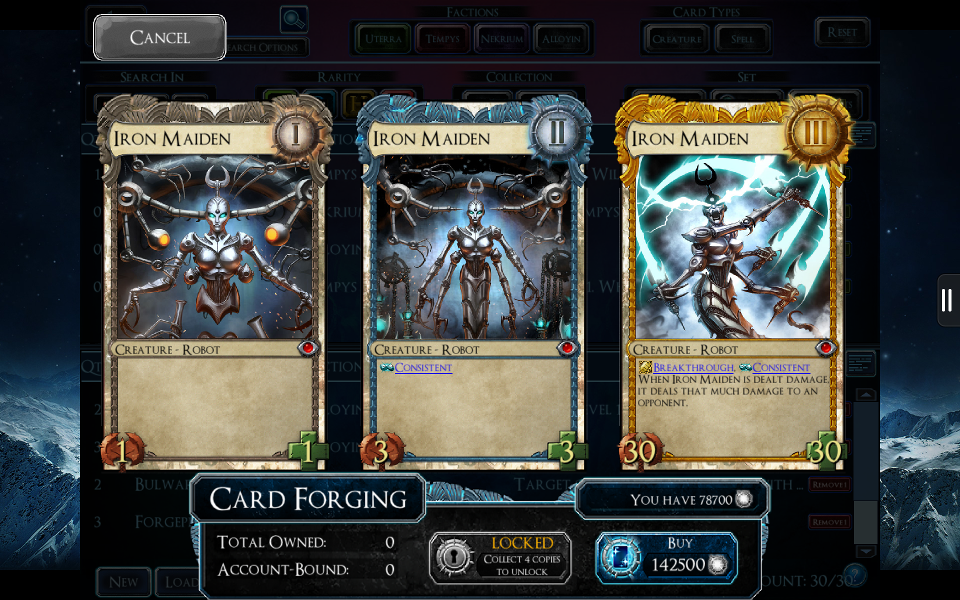
Even though Chrogias is the only one I have a copy of, I’ve played the others in phantom legendary draft. Super satisfying!
